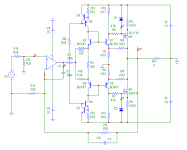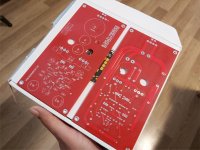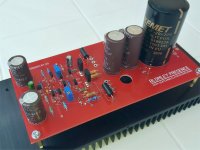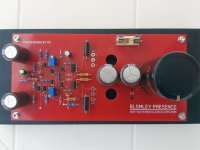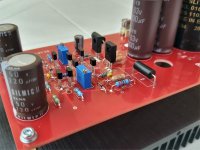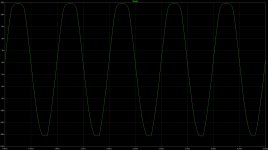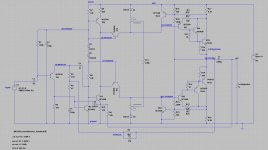NS, switching point, Deltic
Hugh, is the new Deltic amplifier NS? And switching point off the crossover point too?
Aksa Lender P-mos Hybrid Aleph (ALPHA) Amplifier
I have worked with local engineers in the non-switching area, and one, Paul Bysouth, has been quite successful with one NS amp which sounds very good, on par with my flagship amp which is not NS in fact. But his amp is more complex, and the H5/H7/H9 artefacts appear to be about the same as my non-NS design so on balance I do not see much advantage. In light of the last poster it could be related to the speed of the correction transistors; like error correction this technology requires actives which are perhaps a speed order of magnitude higher than the outputs, which is problematic...
My recent work is an attempt to move the switching point off the crossover point. If the passive device in an AB PP output stage can switch off a few volts well into the active, device duty cycle the death throes of the passive device will be presumably lost in the high current prevailing in the active device.
Hugh, is the new Deltic amplifier NS? And switching point off the crossover point too?
Aksa Lender P-mos Hybrid Aleph (ALPHA) Amplifier
Hi Pavel,I built this some 15 years ago. I think Ian Hegglun would recognize the circuit. It was working very well.
Thanks for mentioning it. Yes, I recognize it from Electronics World. The article with supplementary notes is here
BTW what bias current did you use? Did you use a trimpot for nulling DC on the output? Did you do any distortion measurements.
IH
BTW what bias current did you use? Did you use a trimpot for nulling DC on the output? Did you do any distortion measurements.
IH
Hi Jan,
Bias current was about 350mA. I did not use the trimpot, as I recall the DC offset was in mV order. I did distortion measurements, however as it was about 15 years ago, they are "stored" in my old IBM PC working under Win NT4.0, which has not been used for long long time. I remember that distortion was pretty low, especially into 8ohm load, distortion was of 0.001% order at 1kHz, probably rising with frequency. Sound was very good.
Thank you for providing the link to the article!
Last edited:
I can confirm: Blomley's amp sounds excellent and works stable.
After I’ve read Dermot Herrons great article about Blomley's amplifier I’ve decided to build this awesome amplifier. I designed my own PCB, and used quality parts. All semiconductors were closely matched.
Pros:
- Hyperdetailed sound (unexpected).
- Totally neutral. No warm (despite singleton input), nor sterile or dry .
- Dynamically and rhythmically strong
- Instrument separation
- Thermally and electrically stable
- Runs very cold
- Efficiency (~70%)
- Easy to build
Cons:
- A little bit weak in bass
- Need a sensitive speaker
- Build a high quality power supply for optimal result
This amp runs stable and sounds excellent. The Blomley Presence NS Class b amp is one of the very few solid state amplifier which totally free from transistor sound (grainnes).
Is it as good as a good Class A amp? Well, different. Blomley has fast, precise and neutral sound, and has much more detail than some Class A amp (compared to Hiraga 8W, JLH 1969). Extremely clean and and trasparent. I like it more, than Class A amps.
... Those who have built that amplifier,can they share with us their experience and detail how the amp works.
Thanks.
After I’ve read Dermot Herrons great article about Blomley's amplifier I’ve decided to build this awesome amplifier. I designed my own PCB, and used quality parts. All semiconductors were closely matched.
Pros:
- Hyperdetailed sound (unexpected).
- Totally neutral. No warm (despite singleton input), nor sterile or dry .
- Dynamically and rhythmically strong
- Instrument separation
- Thermally and electrically stable
- Runs very cold
- Efficiency (~70%)
- Easy to build
Cons:
- A little bit weak in bass
- Need a sensitive speaker
- Build a high quality power supply for optimal result
This amp runs stable and sounds excellent. The Blomley Presence NS Class b amp is one of the very few solid state amplifier which totally free from transistor sound (grainnes).
Is it as good as a good Class A amp? Well, different. Blomley has fast, precise and neutral sound, and has much more detail than some Class A amp (compared to Hiraga 8W, JLH 1969). Extremely clean and and trasparent. I like it more, than Class A amps.
Attachments
Last edited:
Beautiful!
You have screenshots from oscilloscope to see how it performs?
I have one variation of Blomley amp in the works, but it doesn't really sim that well..
Thank you, Minek. Honestly I don't have any oscilloscope at this time, so I used DMM, and a transistor tester only. Blomley works well from the first turn on, its very stable and cool. Short cable, long cable, high capacity cable, it all doesn’t matter. It stays stable and cool (w/o Zobel). It is in daily use for three months and is stable. Totally free from hum and noise. I hear nothing even I glue my ear to tweeter. I also want to buy an oscilloscope soon and then measure Blomley and Wiederhold with it. Blomley sounds very clear and detailed, just somehow a bit lifeless. And not powerful enough.
Attachments
Last edited:
Pots are for both: bias AND DC offset regulation.
This process is slightly convoluted..
It is described in the original Peter Blomley's article..
Here is less convoluted version:
https://www.diyaudio.com/forums/solid-state/357369-unusual-amp-1987-a-45.html#post6407095
This process is slightly convoluted..
It is described in the original Peter Blomley's article..
Here is less convoluted version:
https://www.diyaudio.com/forums/solid-state/357369-unusual-amp-1987-a-45.html#post6407095
Last edited:
When I first read about Blomley's amp I concluded that what he had done was to introduce a design which had, intrinsically, crossover distortion even though the output transistors operated with a continuous bias. The crossover distortion is illustrated by one of the graphs in his article showing the voltage excursion at the phase splitter circuit. The signal has to make a jump of about 300mV in next to no time. Rather than the output stage operating underbiased this is moved earlier to the diode/transistor phase splitter pair.
Now having simulated the design there is some odd harmonic distortion at 14V rms output suggesting crossover distortion, and a rather high 0.3% THD. (by today's standard, at least, that is high. Back then it would not have been too bad).
What I would say though is that the design is largely free of transient distortion and this may explain the audio quality. The crossover distortion may reduce at lower output levels, but I haven't run the sims. to check.
Finally, I tried similar ideas in the past but another problem is that at 20kHz the output transistor currents aren't fixed to the quiescent current which seems to be due to some "overlap" where the "on" half still manages to pull current from the "off" half.
It's an interesting concept and Peter's circuit works but not I think as well as might be. In his article Peter mentioned "further work" to explore the ideas.
I wonder if the silicon and germanium diode bias ought to be replaced by a Vbe multiplier which can be set to a point where the drivers just begin to turn on the output stage. This would reduce the voltage jump required, which should reduce crossover distortion. Also, possibly adjusting the output stage current up somewhat so that the drivers and output devices are fully on during a 20kHz signal swing. That would be a rather tricky setup operation but may be worthwhile.
Now having simulated the design there is some odd harmonic distortion at 14V rms output suggesting crossover distortion, and a rather high 0.3% THD. (by today's standard, at least, that is high. Back then it would not have been too bad).
What I would say though is that the design is largely free of transient distortion and this may explain the audio quality. The crossover distortion may reduce at lower output levels, but I haven't run the sims. to check.
Finally, I tried similar ideas in the past but another problem is that at 20kHz the output transistor currents aren't fixed to the quiescent current which seems to be due to some "overlap" where the "on" half still manages to pull current from the "off" half.
It's an interesting concept and Peter's circuit works but not I think as well as might be. In his article Peter mentioned "further work" to explore the ideas.
I wonder if the silicon and germanium diode bias ought to be replaced by a Vbe multiplier which can be set to a point where the drivers just begin to turn on the output stage. This would reduce the voltage jump required, which should reduce crossover distortion. Also, possibly adjusting the output stage current up somewhat so that the drivers and output devices are fully on during a 20kHz signal swing. That would be a rather tricky setup operation but may be worthwhile.
Pros:
- Hyperdetailed sound (unexpected).
- Totally neutral. No warm (despite singleton input), nor sterile or dry .
- Dynamically and rhythmically strong
- Instrument separation
- Thermally and electrically stable
- Runs very cold
- Efficiency (~70%)
- Easy to build
Cons:
- A little bit weak in bass
- Need a sensitive speaker
- Build a high quality power supply for optimal result
strange, I might say the same about transconductance amplifiers (possible boomy bass instead of weak @ CONS, warmer heatsinks, minor efficiency)...
strange, I might say the same about transconductance amplifiers (possible boomy bass instead of weak @ CONS, warmer heatsinks, minor efficiency)...
I replaced 220uF in feedback network to 470uF, now bass seems OK. Yes, its very efficient. Drivers transistors run without heatsinks, it stay just slightly warm even is heavy use. Quiescent current set to 25mA. BTW John Ellis is right. Its sound is noticeably better if I set the quiescent current to 60mA.
Who is being fooled here? This idea serves as a prime example of wishful thinking, a very common scenario in audio. "Crossover distortion" is just another conceptual nonsense. However, if you are tolerant against switching distortion, with modern techniques and parts, at no time in the past was it easier to obtain high efficiency.
Thank you, Minek. Honestly I don't have any oscilloscope at this time, so I used DMM, and a transistor tester only. Blomley works well from the first turn on, its very stable and cool. Short cable, long cable, high capacity cable, it all doesn’t matter. It stays stable and cool (w/o Zobel). It is in daily use for three months and is stable. Totally free from hum and noise. I hear nothing even I glue my ear to tweeter. I also want to buy an oscilloscope soon and then measure Blomley and Wiederhold with it. Blomley sounds very clear and detailed, just somehow a bit lifeless. And not powerful enough.
Hello, I can't open this ASC with Altium Designer or PADS 9.5. What is the problem? What software is used to open?
There was a recent article on the Blomley over on 'allaboutcircuits'. Its a great read.
My 40-Year Love Affair with a Remarkable Amplifier—A Class B Amplifier for Audiophiles
I also did a sim for curiosity. You will need to put your own models into it and alter voltage source V1 to get the desired quiescent current:
Hello, I can't open this ASC with Altium Designer or PADS 9.5. What is the problem? What software is used to open?
- Home
- Amplifiers
- Solid State
- The Blomley Class B amplifier
